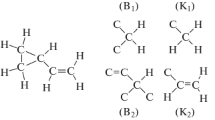Abstract
A new graph theory-based methodology is proposed for the statistical evaluation of the link between the structure and the chemical/biological activity of organic molecules. The computer-aided analysis involves the heuristic processing of molecules as chemical graphs which are decomposed into their component subgraphs. Common topological features among the subgraphs are then statistically isolated, and a set of rules is developed that can be used to explain the activities of the analyzed compounds as well as predict the activities of new compounds. The validity of the methodology is demonstrated by its application to actual experimental data.
Similar content being viewed by others
References
L. Kier and L. Hall,Molecular Connectivity in Chemistry and Drug Research (Academic Press, New York, 1976).
N. Trinajstić,Chemical Graph Theory, Vols. 1 and 2 (CRC Press, 1983).
M. Randić, J. Amer. Chem. Soc. 97 (1975)6609.
L. Kier, J. Pharm. Sci. 69 (1980)807.
G. Klopman, C. Raychaudhury and R. Henderson, Math. Comput. Modelling 2 (1988)635.
S. Grossman, B. Dzonova and M. Randić, Int. J. Quant. Chem. 12 (1986)123.
W.R. Muller, K. Szymanski, K. Knop and N. Trinajstić, J. Comput. Chem. 8 (1987)170.
G. Schafer, Statist. Sci. 2 (1987)3.
G. Klopman, J. Amer. Chem. Soc. 106 (1984)7315.
Laplace,A Philosophical Essay on Probabilities (Dover Publ., New York, 1951).
D.E. Bailey,Probability and Statistics — Models for Research (Wiley, New York, 1971).
T.H. Lowry and K.S. Richardson,Mechanism and Theory in Organic Chemistry (Harper and Row, New York, 1976).
G. Klopman and M. McGonigal, J. Chem. Inf. Comput. Sci. 21 (1981)48.
J.S. Wishnok, ACS Symp. Ser. Amer. Chem. Soc., Washington, DC (1981), pp. 77–87.
W. Lijinsky and H.W. Taylor, Cancer Res. 36 (1976)1988.
S. Wold and W.J. Dunn, J. Chem. Inf. Comput. Sci. 23 (1983)6.
Author information
Authors and Affiliations
Rights and permissions
About this article
Cite this article
Klopman, G., Henderson, R.V. A graph theory-based “expert system” methodology for structure-activity studies. J Math Chem 7, 187–216 (1991). https://doi.org/10.1007/BF01200823
Issue Date:
DOI: https://doi.org/10.1007/BF01200823




